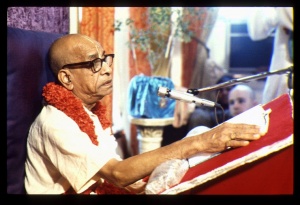SB 11.5.32

A.C. Bhaktivedanta Swami Prabhupada
Please note: The synonyms, translation and purport of this verse were composed by disciples of Śrīla Prabhupāda
TEXT 32
- kṛṣṇa-varṇaṁ tviṣākṛṣṇaṁ
- sāṅgopāṅgāstra-pārṣadam
- yajñaiḥ saṅkīrtana-prāyair
- yajanti hi su-medhasaḥ
SYNONYMS
kṛṣṇa-varṇam — repeating the syllables kṛṣ-ṇa; tviṣā — with a luster; akṛṣṇam — not black (golden); sa-aṅga — along with associates; upa-aṅga — servitors; astra — weapons; pārṣadam — confidential companions; yajñaiḥ — by sacrifice; saṅkīrtana-prāyaiḥ — consisting chiefly of congregational chanting; yajanti — they worship; hi — certainly; su-medhasaḥ — intelligent persons.
Translation and purport composed by disciples of Śrīla Prabhupāda
TRANSLATION
In the age of Kali, intelligent persons perform congregational chanting to worship the incarnation of Godhead who constantly sings the names of Kṛṣṇa. Although His complexion is not blackish, He is Kṛṣṇa Himself. He is accompanied by His associates, servants, weapons and confidential companions.
PURPORT
This same verse is quoted by Kṛṣṇadāsa Kavirāja in the Caitanya-caritāmṛta, Adi-līlā, Chapter Three, verse 52. His Divine Grace A.C. Bhaktivedanta Swami Prabhupāda has given the following commentary on this verse. "This text is from Śrīmad-Bhāgavatam(SB 11.5.32). Śrīla Jīva Gosvāmī has explained this verse in his commentary on the Śrīmad-Bhāgavatam known as the Krama-sandarbha, wherein he says that Lord Kṛṣṇa also appears with a golden complexion. That golden Lord Kṛṣṇa is Lord Caitanya, who is worshiped by intelligent men in this age. That is confirmed in Śrīmad-Bhāgavatam by Garga Muni, who said that although the child Kṛṣṇa was blackish, He also appears in three other colors—red, white and yellow. He exhibited His white and red complexions in the Satya and Tretā ages respectively. He did not exhibit the remaining color, yellow—gold, until He appeared as Lord Caitanya, who is known as Gaurahari.
"Śrīla Jīva Gosvāmī explains that kṛṣṇa-varṇam means Śrī Kṛṣṇa Caitanya. Kṛṣṇa-varṇam and Kṛṣṇa Caitanya are equivalent. The name Kṛṣṇa appears with both Lord Kṛṣṇa and Lord Caitanya Kṛṣṇa. Lord Śrī Caitanya Mahāprabhu is the Supreme Personality of Godhead, but He always engages in describing Kṛṣṇa and thus enjoying transcendental bliss by chanting and remembering His name and form. Lord Kṛṣṇa Himself appears as Lord Caitanya to preach the highest gospel. Varṇayati means 'utters' or 'describes.' Lord Caitanya always chants the holy name of Kṛṣṇa and describes it also, and because He is Kṛṣṇa Himself, whoever meets Him will automatically chant the holy name of Kṛṣṇa and later describe it to others. He injects one with transcendental Kṛṣṇa consciousness, which merges the chanter in transcendental bliss. In all respects, therefore, He appears before everyone as Kṛṣṇa, either by personality or by sound. Simply by seeing Lord Caitanya one at once remembers Lord Kṛṣṇa. One may therefore accept Him as viṣṇu-tattva. In other words, Lord Caitanya is Lord Kṛṣṇa Himself.
"Sāṅgopāṅgāstra-pārṣadam further indicates that Lord Caitanya is Lord Kṛṣṇa. His body is always decorated with ornaments of sandalwood and with sandalwood paste. By His superexcellent beauty He subdues all the people of the age. In other descents the Lord sometimes used weapons to defeat the demoniac, but in this age the Lord subdues them with His all-attractive figure as Caitanya Mahāprabhu. Śrīla Jīva Gosvāmī explains that His beauty is His astra, or weapon, to subdue the demons. Because He is all-attractive, it is to be understood that all the demigods lived with Him as His companions. His acts were uncommon and His associates wonderful. When He propagated the saṅkīrtana movement, He attracted many great scholars and ācāryas, especially in Bengal and Orissa. Lord Caitanya is always accompanied by His best associates like Lord Nityānanda, Advaita, Gadādhara and Śrīvāsa.
"Śrīla Jīva Gosvāmī cites a verse from the Vedic literature that says that there is no necessity of performing sacrificial demonstrations or ceremonial functions. He comments that instead of engaging in such external, pompous exhibitions, all people, regardless of caste, color or creed, can assemble together and chant Hare Kṛṣṇa to worship Lord Caitanya. Kṛṣṇa-varṇaṁ tviṣākṛṣṇam (SB 11.5.32) indicates that prominence should be given to the name Kṛṣṇa. Lord Caitanya taught Kṛṣṇa consciousness and chanted the name of Kṛṣṇa. Therefore, to worship Lord Caitanya, everyone should together chant the mahā-mantra—Hare Kṛṣṇa, Hare Kṛṣṇa, Kṛṣṇa Kṛṣṇa, Hare Hare/ Hare Rāma, Hare Rāma, Rāma Rāma, Hare Hare. To propagate worship in churches, temples or mosques is not possible because people have lost interest in that. But anywhere and everywhere, people can chant Hare Kṛṣṇa. Thus worshiping Lord Caitanya, they can perform the highest activity and fulfill the highest religious purpose of satisfying the Supreme Lord.
"Śrīla Sārvabhauma Bhaṭṭācārya, a famous disciple of Lord Caitanya, said: 'The principle of transcendental devotional service having been lost, Śrī Kṛṣṇa Caitanya has appeared to deliver again the process of devotion. He is so kind that He is distributing love of Kṛṣṇa. Everyone should be attracted more and more to His lotus feet, as humming bees are attracted to a lotus flower.' "
The incarnation of Caitanya Mahāprabhu is also described in the Śrī Viṣṇu-sahasra-nāma, which appears in Chapter 189 of the Dāna-dharma-parva of Mahābhārata. Śrīla Jīva Gosvāmī has quoted this reference as follows: suvarṇa-varṇo hemāṅgo varāṅgaś candanāṅgadī. "In His early pastimes He appears as a householder with a golden complexion. His limbs are beautiful, and His body, smeared with the pulp of sandalwood, seems like molten gold." He has also quoted, sannyāsa-kṛc chamaḥ śānto niṣṭhā-śānti-parāyaṇaḥ: "In His later pastimes He accepts the sannyāsa order, and He is equipoised and peaceful. He is the highest abode of peace and devotion, for He silences the impersonalist nondevotees."